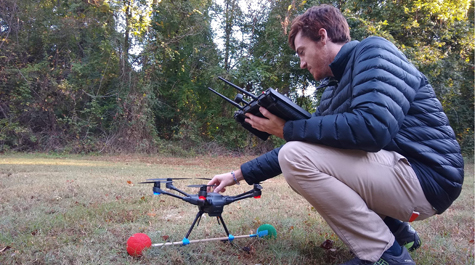W&M grad student wins national wildlife conservation award
Timothy Boycott, a graduate student in the Department of Biology at William & Mary, was recently awarded the Christine Stevens Wildlife Award from the Animal Welfare Institute.
The award, given to only six national recipients this year, recognizes researchers who are developing innovative wildlife study techniques and new methods for resolving wildlife and human conflicts, the institute said in a release.
“My research interests are orientated around animal behavioral ecology and conservation biology,” Boycott said. “I am particularly interested in sensory ecology and animal communication.”
Established in 2006, the Christine Stevens Wildlife Award provides researchers individual grants of up to $15,000. It is named in honor of AWI’s late founder and longtime president, who dedicated her life to reducing animal suffering, the release stated.
“The Christine Stevens Wildlife Award aims to inspire a new generation of compassionate wildlife scientists, managers, and advocates,” Cathy Liss, president of AWI, said in the release. “From managing harmful diseases afflicting wildlife, to improving landscape connectivity for multiple species, these exciting research projects demonstrate that less intrusive study methods and humane solutions can help reduce human-wildlife conflicts.”
Boycott’s research is aimed at reducing the number of birds that die from collisions with human-built structures. Boycott began working on the project in the fall of 2018, when he joined W&M's Institute of Integrative Bird Behavior Studies as a graduate student. Called Acoustic Lighthouse, the project aims to create technology to warn flying birds away from deadly collisions using sound.
William & Mary biologist John Swaddle, who chairs the biology department and serves as lead on the Acoustic Lighthouse project, is Boycott’s advisor. Boycott’s thesis work is focused on testing the team’s hypotheses about the influence of acoustic signals on the flight behavior of birds at risk of collisions with tall structures.
“This project encompasses theoretical work investigating the auditory and visual sensory ecology of birds, particularly while in flight,” Boycott said. “The project also aims to directly apply these understandings of avian sensory ecology to an area of much-needed conservation work. Being a part of a project that bridges this theoretical and applied work is very fulfilling.”
The idea behind Acoustic Lighthouse is to get flying birds to look up. Migrating birds look down, and not where they’re flying, Swaddle explained. When a downward-looking bird meets an immovable object, the bird never knows what it hit.
Acoustic Lighthouse technology consists of a directional speaker mounted on a wind turbine or other structure. The speaker projects a sound that alerts approaching birds and prompts them to slow down and look up. And, ideally, fly around the turbine or tower.
“The fundamental knowledge of how birds behave and respond to sound helps us derive these new technologies and solutions,” Swaddle said.
Swaddle said death by wind turbine claims millions of birds each year. If you add in the birds colliding with cell towers, tall buildings and other products of modern life, the count goes up to billions.
Funds from the Christine Stevens Wildlife Award will allow the team to expand the scope of their field studies to include more sampling locations and collect more data, Boycott said.
“This will lend valuable power to our tests and allow us to more accurately evaluate and fine tune this mitigation method,” Boycott said. “Ultimately, our research will offer valuable contributions to the field of avian sensory ecology, and may also lead to a more rapid application of technology like the Acoustic Lighthouse in mitigating avian collisions.”
 Skip to main content
Skip to main content

